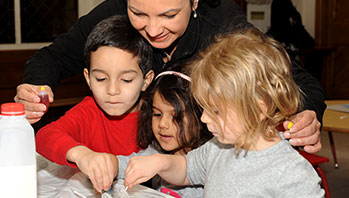- chart paper
- marker
- plastic containers with lids (for example, food storage containers, yogurt containers, plastic eggs)
- small objects (dried beans, beads, paper clips, cotton balls, buttons, packing peanuts)
- recording device (optional)
- tubes and hoses (cardboard and plastic)
- listen
- loud
- loudest
- predict
- quiet
- soft
- softest
- sound
MA Standards:
Speaking and Listening/SL.PK.MA.1: Participate in collaborative conversations with diverse partners during daily routines and play.
Language/L.PK.MA.1: Demonstrate use of oral language in informal everyday activities.
MA Draft STE Standards:
Physical Sciences/Matter and Its Interactions/PS4.B: Apply their understanding in their play of how to change volume and pitch of some sounds.
Head Start Outcomes:
Language Development/Receptive Language: Attends to language during conversations, songs, stories, or other learning experiences.
Language Development/Expressive Language: Uses language to express ideas and needs.
Logic and Reasoning/Reasoning and Problem Solving: Seeks multiple solutions to a question, task, or problem.
Logic and Reasoning/Reasoning and Problem Solving: Recognizes cause and effect relationships.
Science Knowledge/Scientific Skills and Method: Uses senses and tools, including technology, to gather information, investigate materials, and observe processes and relationships.
PreK Learning Guidelines:
English Language Arts/Language 2: Participate actively in discussions, listen to the ideas of others, and ask and answer relevant questions
Science and Technology/Living Things and Their Environment 15: Use their senses of sight, hearing, touch, smell, and taste to explore their environment using sensory vocabulary.
Small Group: More Shake and Listen Indoors

© Commonwealth of Massachusetts, Department of Early Education and Care (Jennifer Waddell photographer). All rights reserved.
STEM Key Concepts: Different objects make different sounds; An action has to happen to make a sound; A sound becomes louder when the force of the action that is creating the sound is increased; A sound becomes softer, or quieter, when the force is decreased
ELA Focus Skills: Speaking and Listening, Vocabulary
Join small groups of children as they explore the materials at the Science and Math Center. Notice what captures their attention. Find opportunities to engage children in conversation, asking them to talk about what sounds they are making or doing and/or what they are observing and wondering about sounds.
Let children experiment with making different sounds by adjusting the way they move the shaker. Encourage them to make soft, sleepy sounds; scary, rattle-y sounds; and sudden, jumpy sounds. You may want to use a digital camera to record their observations and discussions.
